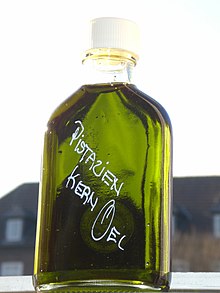
Pistachio oil is a pressed oil, extracted from the fruit of Pistacia vera, the pistachio nut.
Composition
In all vegetable oils, the composition can vary depending on the cultivar, environmental conditions, harvesting, and processing. [1] [2]
The intense coloration, very characteristic of pistachio oil, is due to the content of chromophores, particularly chlorophyll and carotenoids. The total carotenoid content has been reported to be 15 - 61 mg/kg, with the main components in order of concentration being lutein, β-carotene, neoxanthin, luteoxanthin, and violaxanthin. The luteoxanthin content apparently increases, becoming the main species, in cold-pressed oils. The total chlorophyll content is much higher in pistachio oils extracted with solvents. The chlorophyll content is 128-200 mg/kg in solvent-extracted oils and 12-50 mg/kg in "virgin" oils, with the main components being chlorophyll a, chlorophyll b, pheophytin a, and pheophytin b. [3]
The high concentration of monounsaturated and polyunsaturated fatty acids makes it susceptible to auto-oxidation, which can be delayed by naturally present tocopherols or added antioxidants. The total sterol concentration detected in unrefined oils is 1840-4500 mg/kg. Other minor components of pistachio oil found in some studies include squalene, phenols with aldehydes, terpenes, and alcohols that give it a characteristic aromatic note. [4] [1] [5] [6]
Culinary uses
Compared to other nut oils, pistachio oil has a particularly strong flavor. Like other nut oils, it tastes similar to the nut from which it is extracted. Pistachio oil is high in Vitamin E, containing 19mg/100g. It contains 12.7% saturated fats, 53.8% monounsaturated fats, 32.7% linoleic acid, and 0.8% omega-3 fatty acid. [7] Pistachio oil is used as a table oil to add flavor to foods such as steamed vegetables. [8]
Manufacturing uses
Pistachio oil is also used in skin care products.
References
- ^ a b Rabadán, Adrián; Álvarez-Ortí, Manuel; Gómez, Ricardo (2018-08-01). "Characterization of pistachio oils and defatted flours regarding cultivar and geographic origin". Journal of Food Composition and Analysis. 71: 56–64. doi: 10.1016/j.jfca.2018.05.008. Retrieved 2019-12-10.
- ^ Givianrad, M. H.; Saber-Tehrani, M.; Mohammadi, S. A. Jafari (2013-03-30). "Chemical composition of oils from wild almond ( Prunus scoparia ) and wild pistachio ( Pistacia atlantica )". Grasas y Aceites. 64 (1): 77–84. doi: 10.3989/gya.070312. Retrieved 2019-12-10.
- ^ Ramadan, Mohamed Fawzy (8 May 2019). "Virgin Pistachio (Pistachia vera L.) Oil". Fruit oils : chemistry and functionality. Springer. pp. 181–198. ISBN 978-3-030-12473-1. OCLC 1100588295. Retrieved 2019-12-10.
- ^ Sonmezdag, Ahmet Salih; Kelebek, Hasim; Selli, Serkan (2018-02-01). "Pistachio oil (Pistacia vera L. cv. Uzun): Characterization of key odorants in a representative aromatic extract by GC-MS-olfactometry and phenolic profile by LC-ESI-MS/MS". Food Chemistry. 240: 24–31. doi: 10.1016/j.foodchem.2017.07.086. PMID 28946268. Retrieved 2019-12-10.
- ^ "Benefits of Pistachios". Fastachi. Retrieved 2024-04-20.
- ^ Salvo, Andrea; La Torre, Giovanna Loredana; Di Stefano, Vita (2017). "Fast UPLC/PDA determination of squalene in Sicilian P.D.O. pistachio from Bronte: Optimization of oil extraction method and analytical characterization". Food Chemistry. 221: 1631–1636. doi: 10.1016/j.foodchem.2016.10.126. hdl: 11573/1371350. PMID 27979139. Retrieved 2019-12-10.
- ^ "Virgin pistachio oil". Archived from the original on 2006-06-19.
- ^ The Nutrition Source - Recipes from Harvard University School of Public Health. Retrieved June 2009.